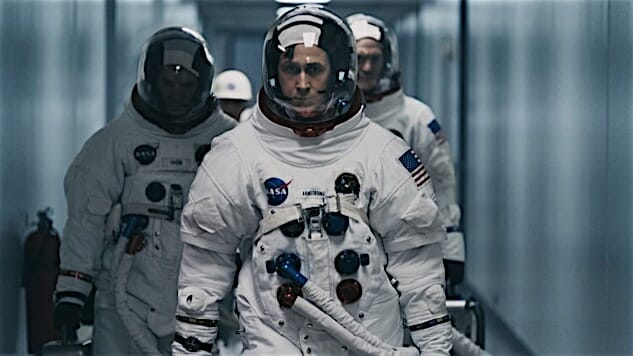First Man

1. First Man does so many things right that you barely notice its real magic trick is how many things it doesn’t do wrong. It is near impossible to avoid all the landmines waiting for a movie about Neil Armstrong and the 1969 moon landing, particularly in the year 2018. There is no big speech about the good old days of America, no wistful pleading for us to reclaim our lost vision and ambition, no plaintive call for a collective mission and a united country in an age when both seem long lost, nigh impossible. This is not to say that First Man does not conjure up these feelings in the viewer—it very much does—but its greatest. accomplishment is that it does it not by nudging the audience, but instead honing in, with precision and purpose, on the job at hand, the man in charge of following it through and what drove him, and those who loved him, to such lengths. It celebrates humanity by focusing intensely on it, in all its glories and failings.
2. We first meet Neil Armstrong (Ryan Gosling) as a remote, almost chilly flyboy who is less Maverick than a willful, stoic technician. The year is 1961, and he and his wife Janet (Claire Foy) are paralyzed by the malignant tumor attacking their daughter Karen’s brain. When she dies, the family barely holds itself together and, in fact, Armstrong joins NASA in large part because the couple’s mourning is tearing them both apart. From there, we follow many of the familiar contours of the NASA story and Armstrong’s part in it, as he digs himself deeper and deeper into his work—and removes himself further and further from his family—in an obsession with … what, exactly? One of the movie’s slyest, most daring and affecting conceits is that we never quite know what’s going on with Armstrong, and neither does anyone else in the film, not least of all Janet, who is left raising two increasingly difficult boys while her husband buries himself in his work, perhaps to hide the grief that consumes him. It just turns out that work is something that’s going to change the world.
3. This would seem like a bit of a turn for director Damien Chazelle, whose Whiplash and La La Land barely seem to exist in the same universe of Neil Armstrong and the space race. But his lyrical intensity, his ability to find the hard edges of his story while still being able to leave us in awe, is a perfect fit for this material. The space sequences, of which there are three major ones, are like musical numbers of their own, with Chazelle plunging us into the terror of what’s happening, the utter sense that, for all the technical know-how and noble intentions, everything could explode at any minute without anyone having the slightest idea why. These were, after all, experiments, and with those experiments came tragic failures. Chazelle is able to ground us with the details while making sure, when it all clicks together, that it can still soar. Chazelle has shown the ability to lift us off our feet before, but this is a major step forward.
-

-

-

-

-

-

-

-

-

-

-

-

-

-

-

-

-

-

-

-

-

-

-

-

-

-

-

-

-

-

-

-

-

-

-

-

-

-

-

-








































